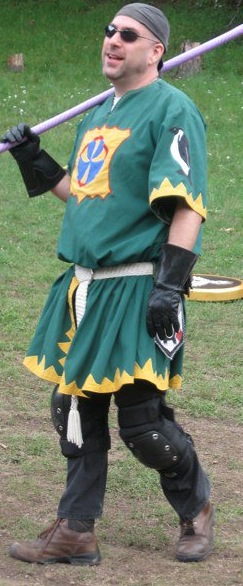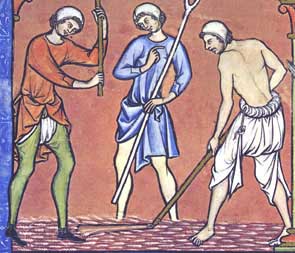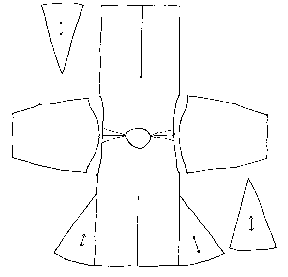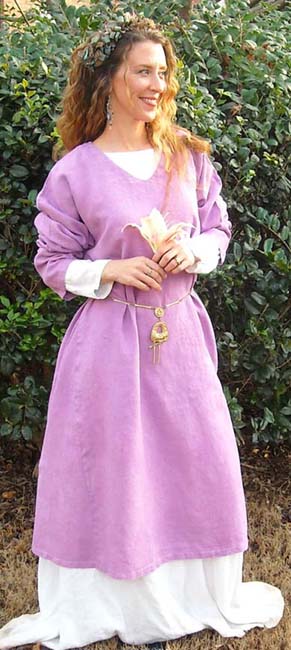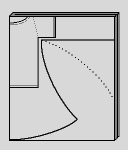Difference between revisions of "Tunic"
m (added category) |
(rewrote entire article, reworked to fit within scope, better explanations of topic, easier read) |
||
| Line 1: | Line 1: | ||
| − | A | + | [[File:Claw Tunic.jpg|thumb|right|[[Rift]] wearing a classic style old style [[Claw]] tunic with [[applique]] around the hem and sleeves]] |
| + | A '''tunic''' is the most common piece of [[garb]] in Amtgard, and is considered the standard piece of torso garb for all genders. It's a simple garment of varying length, reaching from the shoulders to anywhere between the hips and the ankles. It will almost always have sleeves, contrary to the [[tabard]] or [[surcoat]] that do not. Tunics can range from plain fabric to elaborately decorated, often with motifs representing [[fighting companies]] or personal symbols. | ||
| − | == | + | ==Use of tunics== |
| − | + | The tunic has been commonplace throughout history, in daily living and in religious ceremony, from the ancient Greeks through the modern day. Tunics represented an easily made garment that could be worn by all members of society. Tunics were made in many different fabrics, colors, and levels of decoration depending on a person's position, wealth, and even their place of origin. | |
| − | |||
| − | + | ===Historic tunics=== | |
| − | The tunic | + | The word "tunic" derives from the Latin word ''tunica''. It evolved from the Greek ''chiton'', a similar garment, and adopted by both citizens and non-citizens in the Roman Empire. The tunics of male citizens might be worn under a ''toga'' in certain occasions. Both the Greek and Roman varieties of tunic were cut and decorated to indicate wealth, status, and place of origin. |
| − | + | [[Image:Braies.jpg.jpeg|thumb|left|Example of typical working man's attire from 13th century England.]] | |
| − | [[Image: | + | The Celtic and Germanic people residing in the colder regions of Europe wore long-sleeve tunics, usually cut to hang at the mid-thigh or knee. Unlike the Roman tunic, this garment usually contained [[gussets]] under the arms and [[gores]] around the skirt for ease of motion. Both the Viking and the Normans eventually adopted this style. |
| − | |||
| − | The | ||
| − | The | + | The tunic continued to be worn by both men and women during the Middle Ages, often over a [[shirt]] and [[braies]] or [[hose]]. People who could afford to decorated their tunics with [[embroidery]] or [[tablet-woven braids]] along the neck, hem and wrists. |
| − | |||
| − | |||
| − | + | ===Fantasy tunics=== | |
| + | Throughout much of fantasy literature and cinema, tunics are used as the basic form of clothing, similar to their use in history. The pattern used for these tunics may differ from their simple historical counterparts, sometimes looking more like modern clothing, or with added cuts and embellishments to fit the theme of the world. | ||
| − | + | ===Tunics in Amtgard=== | |
| − | + | Tunics are universal throughout Amtgard culture, regardless of [[kingdom]]. In our game, tunics might be called "bell tunics", "t-tunics", or "circle tunics", often in reference to the cut of the garment. Each has a different connotation in different geographical areas, with some prefering the gored bell tunic over a more simple t-tunic, or vice-versa. Length can go from just below the hips to below the knees again, with kingdom styles pervading. | |
| − | |||
| − | |||
| − | |||
| − | |||
| − | |||
| − | |||
| − | |||
| − | |||
| − | |||
| − | |||
| − | |||
| − | |||
| − | |||
| − | |||
| − | |||
| − | |||
| − | + | Tunics are worn by both brand new players and the oldest veterans. Older players and better garbers, as well as people willing to pay for quality, might sport a more embellished tunic than their peers. Alternatively, players who wish to wear minimum garb requirements might prefer a plain tunic, or a new player might wear a lower quality tunic until they can make or buy a better one. | |
| − | + | The design and colors of a tunic often signify a type of allegiance. People often wear garb in the colors of their [[company]], [[household]], [[kingdom]], or [[park]]. The design might also represent a piece of nerd/geek culture, or their own [[heraldry]], or simply a design that the wearer thinks looks good. | |
| − | + | Tunics are sometimes given as gifts to new [[knights]], along with a [[white belt]] and [[spurs]], and might be [[applique]]d with the symbol of their [[knighthood]]. | |
| − | + | ==Making a tunic== | |
| + | [[Image:Hdbytunc.gif|left|thumb|Component pieces of a historical bell tunic]] | ||
| + | [[Image:Lilac standing tunic.jpeg|thumb|Simple tunic made from a variation of the basic "bell tunic" pattern]] | ||
| + | Historic tunics were made from as little fabric as possible, and this is reflected in the patterns to make tunics in Amtgard. Common patterns require straight seams, few measurements, and have a large margin of error. This makes tunics a very good beginner's garb project, though the addition of applique and embellishments can make a complex tunic a challenge for even the most talented of garbers. | ||
| + | ===Materials=== | ||
| + | Historic tunics were usually made of [[wool]], [[linen]], or - if you were rich - [[silk]]. The choice of materials depended on location, supply, and economic prosperity. These materials still hold up for tunics today, though people will also use [[cotton]], [[polyester]], and material blends. Depending on the size, sleeve length, and hem length, tunics can take two to four yards of fabric. | ||
| − | + | Contrary to popular belief, the colors of fabrics in history were not muted and dull. It was simple to get bright colors from natural sources. Even poor people were often able to afford to color their clothing in bright reds, oranges, yellows, greens, and blues, depending on the region and availability of natural dying materials. In some instances, people patterned their clothing in plaids and motifs common to their culture. When fantasy sources are also considered, having clothing of many bright colors is thematic and medieval. | |
| − | |||
| − | |||
| − | + | ===Taking measurements=== | |
| + | Most patterns for tunics require a few measurements to be taken, usually around the head, neck, chest, waist, and/or hips. Since the garment is usually loose, more measurements often are not needed. | ||
| − | + | ===Patterns=== | |
| + | [[Image:IMG 8774-1.jpg|100px|thumb|Child's parti-colored tunic with simple [[applique]] and hood]] | ||
| + | There are many patterns for tunics, depending on the desired look. There are two most common patterns, both simple but slightly different. The "T-tunic", a straighter and looser pattern with less seams, is the simplest pattern but the least fitted. It is only appropriate for shorter tunics, as the skirt allows for less movement, and is cut similarly to a t-shirt. The "bell tunic", the more complex of the two, has more seams but ends up more fitted. The wider skirt is necessary for tunics longer than mid-thigh, which allows for greater movement when walking and on the battlefield. | ||
| − | + | ====T-tunic==== | |
| − | ==== | + | [[Image:Tunic how to.gif|thumb|left|An example diagram of the t-tunic making process]] |
| − | [[Image:Tunic | + | The simplicity of the t-tunic comes from the lack of measurements needed; many instructions only require a baggy t-shirt for marking out the size. Other patterns require only a couple measurements. The downside to this pattern is that, since it isn't based in historical fact or fantastical fit, many patterns use up a lot more fabric that the fabric-saving bell tunic. Most t-tunics go to just above the knees, but they can also go right to the floor, though this is less than ideal for fighting. |
| − | |||
| − | |||
| − | |||
| − | |||
| − | |||
| − | |||
| − | |||
| − | |||
| + | *[http://www.amtgard-eh.com/library/howtotunic.html How to] by [[Sir]] [[Squeak!]] | ||
| + | *[http://www.alonatwotrees.com/library/howto/how2tunic.pdf How To PDF] by [[Vaargard]], also detailing different types of necklines | ||
| + | *[http://www.ehow.com/video_4411681_make-outfits-amtgard-live-rpg.html Example video] by [[Sir]] [[Forest]], with an example of a t-tunic | ||
| + | *[http://www.calistonarmory.com/index.php/download_file/view/6/66/ PDF] by [[Sir]] [[Celdic Fitz Caliston]], with a hybrid t/bell variant, and applique instructions | ||
| − | ==== | + | ====Bell tunic==== |
| − | + | The bell tunic is a history and fantasy favorite; the sweeping skirt allows for ease of movement, especially when fighting. The downside is that it's more complex than a t-tunic, though the seams are simple and the gussest relieve pressure and prevent ripping. Bell tunics can extend all the way down to the ankles, though the common length for combatants in Amtgard is to the knee. If patterned correctly, it can even use less fabric than most t-tunic patterns. | |
| − | + | *[http://www.alonatwotrees.com/library/howto/lindensbasictunics.pdf Instructions] by [[Dame]] [[Linden]], featuring a more fitted version with set-in sleeves. | |
| − | *[http://www.alonatwotrees.com/library/howto/ | ||
| − | |||
| − | |||
| − | + | [[Category:Amtgard Things]] | |
| − | + | [[Category:Amtgard Terms]] | |
| − | |||
| − | |||
| − | |||
| − | |||
| − | |||
| − | |||
| − | |||
| − | |||
| − | |||
| − | |||
| − | [[Category:Amtgard Things]] [[Category:Amtgard Terms]] | ||
[[Category:Amtgard Resources]] | [[Category:Amtgard Resources]] | ||
[[Category:How To]] | [[Category:How To]] | ||
[[Category:Garb]] | [[Category:Garb]] | ||
| − | |||
Revision as of 05:20, 30 March 2016
A tunic is the most common piece of garb in Amtgard, and is considered the standard piece of torso garb for all genders. It's a simple garment of varying length, reaching from the shoulders to anywhere between the hips and the ankles. It will almost always have sleeves, contrary to the tabard or surcoat that do not. Tunics can range from plain fabric to elaborately decorated, often with motifs representing fighting companies or personal symbols.
Contents
Use of tunics
The tunic has been commonplace throughout history, in daily living and in religious ceremony, from the ancient Greeks through the modern day. Tunics represented an easily made garment that could be worn by all members of society. Tunics were made in many different fabrics, colors, and levels of decoration depending on a person's position, wealth, and even their place of origin.
Historic tunics
The word "tunic" derives from the Latin word tunica. It evolved from the Greek chiton, a similar garment, and adopted by both citizens and non-citizens in the Roman Empire. The tunics of male citizens might be worn under a toga in certain occasions. Both the Greek and Roman varieties of tunic were cut and decorated to indicate wealth, status, and place of origin.
The Celtic and Germanic people residing in the colder regions of Europe wore long-sleeve tunics, usually cut to hang at the mid-thigh or knee. Unlike the Roman tunic, this garment usually contained gussets under the arms and gores around the skirt for ease of motion. Both the Viking and the Normans eventually adopted this style.
The tunic continued to be worn by both men and women during the Middle Ages, often over a shirt and braies or hose. People who could afford to decorated their tunics with embroidery or tablet-woven braids along the neck, hem and wrists.
Fantasy tunics
Throughout much of fantasy literature and cinema, tunics are used as the basic form of clothing, similar to their use in history. The pattern used for these tunics may differ from their simple historical counterparts, sometimes looking more like modern clothing, or with added cuts and embellishments to fit the theme of the world.
Tunics in Amtgard
Tunics are universal throughout Amtgard culture, regardless of kingdom. In our game, tunics might be called "bell tunics", "t-tunics", or "circle tunics", often in reference to the cut of the garment. Each has a different connotation in different geographical areas, with some prefering the gored bell tunic over a more simple t-tunic, or vice-versa. Length can go from just below the hips to below the knees again, with kingdom styles pervading.
Tunics are worn by both brand new players and the oldest veterans. Older players and better garbers, as well as people willing to pay for quality, might sport a more embellished tunic than their peers. Alternatively, players who wish to wear minimum garb requirements might prefer a plain tunic, or a new player might wear a lower quality tunic until they can make or buy a better one.
The design and colors of a tunic often signify a type of allegiance. People often wear garb in the colors of their company, household, kingdom, or park. The design might also represent a piece of nerd/geek culture, or their own heraldry, or simply a design that the wearer thinks looks good.
Tunics are sometimes given as gifts to new knights, along with a white belt and spurs, and might be appliqued with the symbol of their knighthood.
Making a tunic
Historic tunics were made from as little fabric as possible, and this is reflected in the patterns to make tunics in Amtgard. Common patterns require straight seams, few measurements, and have a large margin of error. This makes tunics a very good beginner's garb project, though the addition of applique and embellishments can make a complex tunic a challenge for even the most talented of garbers.
Materials
Historic tunics were usually made of wool, linen, or - if you were rich - silk. The choice of materials depended on location, supply, and economic prosperity. These materials still hold up for tunics today, though people will also use cotton, polyester, and material blends. Depending on the size, sleeve length, and hem length, tunics can take two to four yards of fabric.
Contrary to popular belief, the colors of fabrics in history were not muted and dull. It was simple to get bright colors from natural sources. Even poor people were often able to afford to color their clothing in bright reds, oranges, yellows, greens, and blues, depending on the region and availability of natural dying materials. In some instances, people patterned their clothing in plaids and motifs common to their culture. When fantasy sources are also considered, having clothing of many bright colors is thematic and medieval.
Taking measurements
Most patterns for tunics require a few measurements to be taken, usually around the head, neck, chest, waist, and/or hips. Since the garment is usually loose, more measurements often are not needed.
Patterns
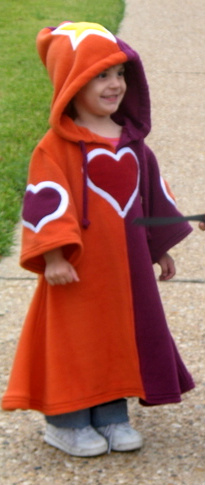
There are many patterns for tunics, depending on the desired look. There are two most common patterns, both simple but slightly different. The "T-tunic", a straighter and looser pattern with less seams, is the simplest pattern but the least fitted. It is only appropriate for shorter tunics, as the skirt allows for less movement, and is cut similarly to a t-shirt. The "bell tunic", the more complex of the two, has more seams but ends up more fitted. The wider skirt is necessary for tunics longer than mid-thigh, which allows for greater movement when walking and on the battlefield.
T-tunic
The simplicity of the t-tunic comes from the lack of measurements needed; many instructions only require a baggy t-shirt for marking out the size. Other patterns require only a couple measurements. The downside to this pattern is that, since it isn't based in historical fact or fantastical fit, many patterns use up a lot more fabric that the fabric-saving bell tunic. Most t-tunics go to just above the knees, but they can also go right to the floor, though this is less than ideal for fighting.
- How to by Sir Squeak!
- How To PDF by Vaargard, also detailing different types of necklines
- Example video by Sir Forest, with an example of a t-tunic
- PDF by Sir Celdic Fitz Caliston, with a hybrid t/bell variant, and applique instructions
Bell tunic
The bell tunic is a history and fantasy favorite; the sweeping skirt allows for ease of movement, especially when fighting. The downside is that it's more complex than a t-tunic, though the seams are simple and the gussest relieve pressure and prevent ripping. Bell tunics can extend all the way down to the ankles, though the common length for combatants in Amtgard is to the knee. If patterned correctly, it can even use less fabric than most t-tunic patterns.
- Instructions by Dame Linden, featuring a more fitted version with set-in sleeves.
